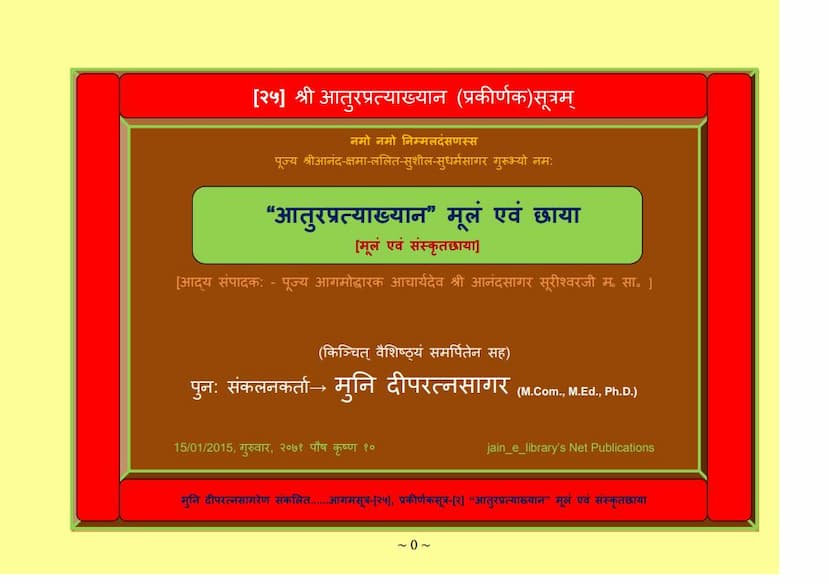Aagam 25 AATUR PRATYAKHYAN Moolam Evam Chaayaa
Added to library: September 1, 2025

Summary
Here's a comprehensive summary of the Jain text "AATUR PRATYAKHYAN Moolam evam Chaayaa," based on the provided pages:
This document presents the Jain Aagam Sutra 25, Prakirnak Sutra 2, titled "Aatur Pratyakhyan" (आत्मन् प्रत्याख्यान - Renunciation for the Patient/Sick). It contains the original text in Prakrit (Moolam) and its Sanskrit translation (Sanskrit Chhaya), compiled by Muni Deepratnasagar.
Key Information about the Publication:
- Original Publication: The text was first published in 1927 (Vikram Samvat 1983) by the Shri Agamoday Samiti as "Chatuh Sharanadi Maranasamadhyantam Prakirnak Dashakam" (चतुःशरणादिमरणसमाध्यन्तं प्रकीर्णकदशकं). It was edited by the revered Acharya Shri Anandasagar Surishwarji Maharaj Saheb (also known as Sagaranand Suriji). This original edition contained 10 Prakirnak sutras.
- New Compilation: The current publication, compiled by Muni Deepratnasagar, is a re-circulation of the original work. He emphasizes that some later publications of this text were merely offset copies of the 1927 edition, with the original editor's and publisher's names removed or downplayed. Muni Deepratnasagar's intention is to honor the original work and its editor while making it more accessible.
- Enhancements: Muni Deepratnasagar's compilation includes:
- A clear structure with the original text and its Sanskrit translation side-by-side.
- Page numbering and internal references (Deep Anukram) for easier navigation across his various Jain Agama publications.
- Special formatting to clearly distinguish between sutra numbers and gatha (verse) numbers.
- An index (Vishayanukram) listing the topics covered by each section.
- Footnotes providing explanations, clarifying printing errors from the original, or correcting numbering issues.
- Digital Format: This version is presented as an "Internet Publication" by jain_e_library.org for wider reach.
Core Content of "Aatur Pratyakhyan":
The text primarily deals with death, the different types of death, and the proper renunciations and attitudes one should adopt, especially when facing illness or imminent death. It guides the practitioner towards a more virtuous and conscious departure from life.
Key Themes and Concepts Covered:
-
Types of Death:
- Baal Pandit Maranam (बालपण्डित मरणं - Ignorant Wise Death): This is described as the death of a person who observes some vows (Desh Virati - partial renunciation) but is still attached to worldly desires, does not perform proper penance (Pratikraman), and dies without being free from internal impurities (Nishallya). This type of death is seen as less ideal.
- Pandit Pandit Maranam (पण्डित पण्डित मरणं - Wise Wise Death): This refers to a death characterized by wisdom, detachment, and proper spiritual practice. The text emphasizes that this is the ideal state to strive for.
-
Vows and Practices:
- Desh Virati (देश विरति - Partial Vows): The text outlines the five Anuvratas (small vows) and seven Shiksha Vratas (disciplinary vows) that constitute partial renunciation.
- Samayika (सामायिक), Paushadh (पोषध), Atithi Samvibhaag (अतिथिसंविभाग): These are highlighted as important practices.
- Pratikraman (प्रतिक्रमण - Retrospection and Confession): A significant portion of the text is dedicated to various forms of Pratikraman, including confessing transgressions related to:
- Ignorance (अज्ञान)
- Bad company (कुसंग)
- False beliefs (मिथ्यादर्शन)
- Kashayas (कषाय - anger, pride, deceit, greed)
- Unwholesome meditations (कुध्यान)
- Worldly attachments (ममत्व)
- Sinful actions (पापप्रयोग)
- Renunciations (Tyaga/Vyutsarg - त्याग/व्युत्सर्जन): The text details the renunciation of:
- Worldly possessions (Upadhi - उपधि)
- Attachments (Mamatva - ममत्व)
- Kashayas, desires, fears, grief, etc.
- Attachment to the body and sensory pleasures.
-
The Nature of the Soul and Liberation:
- The Soul (Atma - आत्मा): The text emphasizes the eternal, unchanging nature of the soul, distinct from external factors and body. It's the soul that experiences birth, death, and ultimately, liberation.
- Karma (कर्म): The accumulation of karma is identified as the root cause of suffering and the cycle of rebirth.
- Liberation (Moksha/Nirvana - मोक्ष/निर्वाण): The ultimate goal is to escape the cycle of birth and death (Samsara - संसार) and attain liberation through right faith, knowledge, and conduct.
-
Guidance for the Dying:
- The text advises facing death with equanimity, detachment, and conscious spiritual practice.
- It cautions against dying with regret, anger, or attachment, as this leads to unfavorable rebirths.
- The importance of remembering the teachings of the Jinas (Jinvachan) and the path to liberation is stressed.
-
Causes of Unfavorable Rebirths (Dev durgati - देवदुर्गति):
- The text explains that negative states of mind, wrong beliefs, association with negative energies (Kṛṣṇa leśyā - कृष्ण लेश्या), and lack of proper spiritual practice during death can lead to unfortunate destinations.
-
Causes of Favorable Rebirths and Liberation:
- Right faith (Samyak Darshan - सम्यग्दर्शन), pure contemplation (Shukla Leśyā - शुक्ल लेश्या), devotion to spiritual teachers, and practicing renunciation lead to favorable outcomes and easier attainment of liberation.
Overall Message:
"Aatur Pratyakhyan" is a practical guide for all individuals, especially those facing life-threatening situations. It underscores the Jain principle of conscious living and dying. It teaches the importance of preparing for death through continuous spiritual practice, ethical conduct, renunciation of attachments, and developing detachment, thereby ensuring a peaceful and fortunate transition towards liberation from the cycle of suffering. The compilation by Muni Deepratnasagar aims to preserve and disseminate this valuable spiritual knowledge effectively.